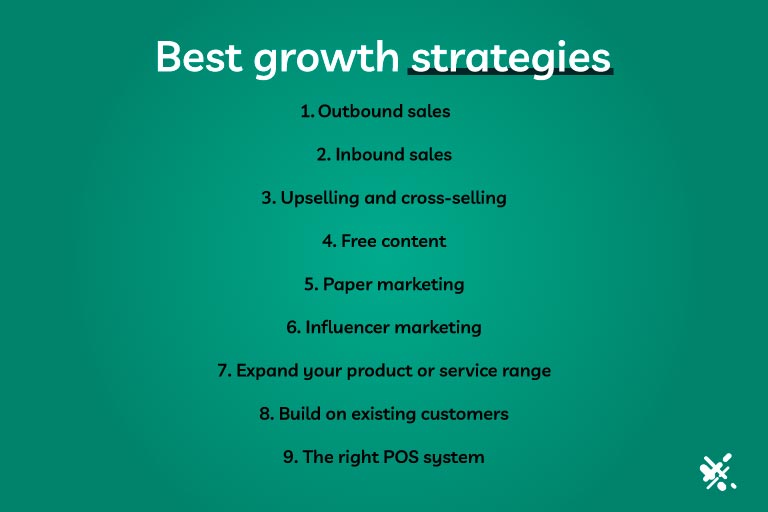Starting a business is half the battle, keeping it going, and maintaining growth is the other half. But understanding your business growth strategies will help shift your focus to the financial success of your future.
Growing a business is one of the most difficult challenges a business owner will face. Over 18% of businesses fail within the first year. 50% fail within a decade. And only 25% of businesses make it past 15 years.
With numbers like these, you might be thinking that staying afloat is more important than growing your business. But as it turns out, the best defense is a good offense.
Why Does a Small Business Need to Grow?
Yes, growth is important ultimately, to make more money, but let’s take a look a bit further to see how and why this is important.
Competition
Business growth is important because of competition. With an estimated 33 million businesses in the United States alone, business growth is a first line of defense against competitors. If your business does not grow, your market share will ultimately be reduced by competing organizations that offer the same products or services.
Cost Per Unit
Business growth is important because it lowers your costs per unit. Product development is an expensive process if your customer base is small. But increased sales mean bigger orders from your vendors, which means bulk discounts.
The same is true for service-based businesses. If you can outsource your services to subcontractors, instead of spending (say) 60 minutes with a client, you’ll spend 10 minutes coordinating their meeting with a subcontractor or employee.
Building Value
Business growth also builds the value of your business. This in turn can help you achieve personal goals such as retirement. If you’d like to sell your company before retiring, a larger company that has already gone through several growth stages is going to fetch a larger price.
What Are the Stages Of Business Growth?
Some business development professionals suggest that a business growth plan is made up of 4 parts, while others suggest 7, and still, others suggest 5. Let’s stick with the lower of the odd numbers, to keep things simple but with a modicum of nuance.
The Startup Stage
The startup phase, or existence phase, often involves the owner entirely funding and managing the company. Formal planning is at a bare minimum and with scant resources and nonexistent credit, cash management must walk a narrow line.
Using market research and customer feedback to refine products or services is crucial. Similarly vital for growing out of this stage, is finding new sources of investment.
The Survival Stage
In the survival stage, a business has established market penetration. The structure of the business is still very simple and ownership is still hands-on.
However, there are now employees who handle the daily operations, leaving the owner free for more executive decision-making. The challenge now is to generate consistent cash flow. The owner must establish a business model and put operational procedures into place.
The Maturity Phases
The next phases of business growth are often referred to as maturity or success. The company is thriving. Profits are consistent. It has achieved long-term brand recognition.
Systems are in place so that the owner does not need to be as involved in decision-making unless they want to be. The main challenge now is to keep the company stable and manage the cash flow so that the company can handle external or internal disruptions.
The Takeoff Stage
The fourth stage of business growth is called takeoff. At this point, a business looking to grow exponentially might go public. This means they would structure themselves as a C-corporation to sell shares of stock.
These shares would help raise the funds necessary for expanding their business at a much larger scale. One of the main challenges will be to keep systems and processes running smoothly while the company goes through its biggest growth yet.
The Final Stage
In the final phase, a business hits resource maturity. The goal now is to properly manage the resources it gained during growth. This includes not only their cash and their cash flow, but the procurement of resources and talent to keep the business running.
Systems are well developed and set in place. But even now the owner must not lose sight of their competitive, entrepreneurial spirit. Even the largest companies in every industry must continue to defend their market share against similarly-sized competitors.
The upshot of these cycles is that business growth is a journey, not a destination. A business should always be growing if its owner wants to stay successful. But how exactly can they do that? What are some business growth strategies? Is one better than the others?

What is The Best Growth Strategy?
That really depends on your business and your market. What works well in a B2B setting (direct sales) does not always work in a B2C setting. And what works in B2C settings (influencer marketing) does not always work in a B2B setting.
And sometimes there is some overlap between the two (free content, paid ads, and deepening customer relationships). So let’s take a look at some common business growth strategies and their pros and cons.
- Outbound Sales
The first business growth strategy that we’ll discuss is one of the oldest: sales. While direct selling is less common in B2C contexts, it is pretty much how B2B organizations build their business. Sales teams are how corporations secure corporate customers.
At the corporate level, sales deals are a complex process that can take months and sometimes years to play out. With certain products such as software, they require tailoring the product to the customer to address specific needs.
The sales process often begins with lead generation. An inside sales team will cold call and email prospects. If the conversation is successful, they will arrange for the client to meet with an account manager.
The account manager is supported by a whole backend team. This includes product managers who meet with the client and customize the end product or service, and it also includes legal and financial support to structure the deal.
Small and midsize businesses can also use the outbound sales process to grow their business. You may not be able to have an entire sales team, but you could hire one or two salespeople to generate more business.
These sales reps will be responsible for prospecting, which includes finding potential clients and researching their organization. They will be responsible for meeting with clients, presenting your product or service, and closing deals. If you’re concerned about the cost of paying for sales reps, you can outsource your sales to a company or an independent contractor.
- Inbound Sales
In a related vein of business growth strategies is inbound selling. Inbound selling happens when customers call your customer service number. Your representative will solve the customer’s problem and in the course of the call talk to the customer and get to know them a little better. This conversation will ideally segue into a sale.
Inbound selling is successful because the customer is already engaged with your business. Financial services is one industry where inbound selling is commonly used. A customer may go into the bank to ask something about their checking account. They meet with a banker, who asks them about other areas of life.
In the course of the conversation, they may uncover that the client is hoping to buy a new home, a new car, or pay for some life milestone. This conversation becomes a stepping stone toward other financial products: mortgages, auto loans, and HELOCs.
You can use inbound sales in your business as well. It does require some additional instruction for your employees and guidance on how to uncover needs in a conversation. If your business uses CRM (customer relationship management software), it may help guide your employees to suggest certain products during the course of the conversation.

- Upselling and Cross-Selling
Upselling is a business growth strategy when you suggest something else for the customer to purchase at the point of sale. In brick-and-mortar settings, upselling usually involves selling an insurance policy to cover the underlying item. And while it is not really upselling per se, many stores encourage their cashiers to offer store credit cards at the point of sale.
Both of these products generate additional revenue for the business, in different ways. The insurance policy generates a commission for the store, from the insurer. And the credit card encourages the shopper to shop at this particular store more often. In fact, more than 60% of polled consumers agree that they will shop more often at stores for which they have a credit card.
Online, upselling is different. It’s also easier, and much more effective. That’s because your sales platform can visually show customers items that are typically bundled together. This is difficult to do seamlessly in person.
For many consumers, it would even be annoying or invasive. But for some reason, if they’re shopping online, they don’t mind you telling them that customers who bought this toothpaste also bought this toothbrush, this floss, and this ceramic monkey toothbrush holder (it was banana-flavored toothpaste, after all).
Technically, this type of sale is called cross-selling. Upselling is getting the customer to buy a higher-end variation of the same item, or some high-end item to compliment what they’ve ordered…like a bottle of wine at a restaurant (but if I may, I really recommend this Spanish import…it compliments the paella so nicely).
For simplicity’s sake, we will use the terms interchangeably. Upselling and cross-selling can increase revenue by 30% for some businesses. In eCommerce, an average of 27% of a store’s revenue is from upselling and cross-selling.
- Free Content
There’s no such thing as free lunch, they always say. And while free lunch has often been used by salespeople to score a new client, it’s a little bit hard to do free lunch on the internet. Or is it? Allow us to introduce content marketing.
Content marketing is a business growth strategy that involves giving your expertise away for free. This might come in the form of a blog, free eBook, video, or social media page. While presenting customers with their free content, you will want to collect some type of contact information…preferably email.
You can use this contact information to continue to deliver content to the customer. For instance, if you have their email, you can deliver a 5-part series of information to them, which concludes with a call to action. Let’s take a look at a content-driven sales funnel.
Suppose you grow artichokes on the family farm. Your social media channel is full of videos of you cooking artichoke-related recipes…artichoke dip, roasted artichokes, and artichoke pasta, to name a few.
At the end of each video, you offer a free artichoke cookbook PDF. To download the PDF, followers must provide their email. These emails can then be used to sell them (you guessed it) farm raised ‘chokes.
Can content marketing actually help you achieve your goals? Companies that adopted this marketing strategy are spending 62% less on marketing, ranking 434% better on search engine pages, and generating 97% more backlinks (links to your content posted by internet users…as in: hey ya’ll—check out this amazing grilled ‘choke recipe video). And ultimately, they are generating 5 times the number of sales leads.
- Paper Marketing
This business growth strategy seems like a curveball, doesn’t it? Especially after that previous section. But paper marketing is not to be overlooked. In fact, it seems to be making a comeback. Due in part to how saturated the internet has become (lots of ‘choke chefs out there).
These days, paper mailing almost catches consumers off guard. Printed ads foster a sense of trust among 82% of consumers. Some estimates suggest that 80% of consumers act on direct paper mailing. And as many as 95% of consumers under 25 still read magazines, with 92% of them saying printed material is easier to digest than its digital counterparts.
All of this bodes well for traditional print marketing, whether it’s an ad in a publication or direct mailings. Consumers also have a much higher ad recall for print ads than digital ads, increasing 67% in the past decade. This may be attributable to the fact that users are bombarded by online material, but are able to focus more on print marketing.

- Influencer Marketing
Influencer marketing is a market penetration strategy whereby you give your products or services to “popular” people. Or rather than “give away” they may already be using your products or services. Then they post about it on their social media channels, and their millions of adoring fans turn to your business.
Sounds simple, and it is. Influencer marketing relies on social proof, which has long been regarded as one of the strongest trust signals in business. But do you really need to get someone famous to wear your shirts, drink your kombucha, or stay at your bed and breakfast?
No, you don’t. In fact, brands are using micro-influencers ten times more than mega-influencers. Micro-influencers might only have a few thousand or tens of thousands of followers, but very engaged communities of people who have rallied around niche topics. The end result is that your business can leverage influencer marketing successfully, without having to pay millions of dollars for a celebrity to endorse your product.
Consumers trust influencers. Around 80% of consumers have purchased something because of an influencer recommendation. 41% of consumers discover new products through influencers at least once a week, and 24% every day. And 75% of consumers will spend up to $629 on an influencer-suggested purchase. That’s a whole lotta ‘chokes.
- Expand Your Product or Service Range
Creating new products is another business growth strategy. This is how many businesses expanded or continue to expand. Think of large food-related conglomerates like Pepsico.
Pepsico doesn’t just sell Pepsi. They also own Quaker Oats products and Frito-Lay snack foods. Most of the food products you recognize are actually owned by ten different corporations.
To clarify, these product lines were acquired by their parent companies. Mergers and acquisitions are not commonplace occurrences in the world of SMBs. However, an analogous path for your organization’s growth would be to develop new products or services.
These products or services do not have to be estranged from your current menu. In fact, it’s better if they’re close to it. If you own a restaurant, you could explore getting a liquor license or selling prepackaged sauces and dressings from the kitchen. If you own a nail salon, you could expand your storefront to include hair styling and a massage parlor.
Whatever the particulars are, expanding your footprint can attract new customers, and also provide deeper engagement with the ones you already have. This brings us to our final point.
- Build On Existing Customers
The next business growth strategy we have is to build on your existing customers. Customer Acquisition Cost (CAC) and Customer Lifetime Value (CLV) are two very important statistics in terms of managing cash flow and increasing revenue. The lower you can keep the former and the higher you can make the latter, the better off your business will be.

Customer Acquisition Cost (CAC)
CAC varies widely from industry to industry. In B2B fintech, the average CAC may be as high as $1,400. But in B2C eCommerce, it could be as low as $86. Where your business falls in the spectrum has a lot to do with what your business is and the market in general.
But no matter what these numbers are, it’s always less expensive to tap into your existing customer base. Part of this might involve the above-mentioned point about expanding your range of goods and services. Hey everybody, come on down to Papi’s—we’re now serving margaritas. Bring a friend! Mariachi Mondays are two-for-one…on the rocks.
Customer Lifetime Value (CLV)
Customer retention is an art, especially with so many choices. Staying in touch with your customers goes a long way, as do loyalty programs. Around 85% of Gen Xers and 80% of Gen Zers, will specifically shop more often with a certain brand because of a loyalty program.
Despite the sea of choices out there, consumers are a loyal bunch. 55% of consumers are loyal to 1-5 brands, while only 2.7% have no loyalty at all. Building brand loyalty is often a very psychological enterprise that involves building rapport and positive emotional experiences.
This is probably why the holiday season is one of the biggest marketing opportunities of the year for most businesses… because consumers now associate their buying options with the warmth of a roaring fire, cookies, milk, and Home Alone (what can we say…it’s a ritual).
Building on existing customers is not just for the holiday season. All year round, it’s prime time to send emails and coupons. It’s always good to offer stellar customer service. And integrating your point-of-sale hardware and software with a loyalty program also goes a long way.
- The Right POS System
Interestingly, many of these business growth strategies are aided and abetted by having the right hardware and software. These aspects of your business can improve customer experience. They can also provide you with the analytics to make decisions about your marketing efforts.
For example, a POS system tied into your inventory can tell you what items are selling, when, and what other items they are selling with. You can use this information to generate marketing campaigns, develop new product lines, and run in-store promotions.
Growing Your Business: A Wrap-Up
Even if you were content to do the same thing day in and day out for decades, your customers aren’t. As you already know, there are similar businesses out there that are competing for the same people. If you don’t engage in a constant effort to grow your business, you could lose market share to your arch-nemesis.
And if both of you (or however many competitors you have) are lax in the area of business growth, you could all lose. Behemoths like Amazon and Walmart are encroaching on Main Street, once again. They are branching out from offering goods alone to offering services as well, both B2B and B2C.
Walmart (for example) can do oil changes, develop photos, and even bake custom cakes. If you don’t want to be put out of business by a Fortune 500 company, it’s time to get up and start growing. The good news is that consumer loyalty is out there. You just have to leverage the right business growth strategies and put your money in the right place.
To learn more about how payment processing technology can assist in business growth, give us a call or fill out the contact form below.
